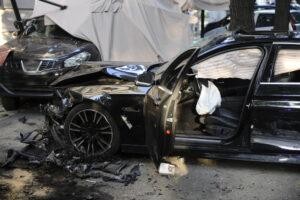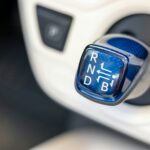It might seem counterintuitive, but car accidents are often more likely to happen in familiar places. While high-speed highways and unfamiliar roads can feel inherently risky, statistics reveal a different story about where collisions most frequently occur. Understanding these common locations is the first step in staying safe and informed on the road.
 Infographic showing common car accident locations: near home, rural roads, intersections, and parking lots.
Infographic showing common car accident locations: near home, rural roads, intersections, and parking lots.
Common Car Crash Locations
Car accidents can happen anywhere, but data consistently points to certain locations as hotspots. Awareness of these areas can help drivers be more vigilant and reduce their risk of being involved in a collision.
Near Home: Familiarity Breeds… Crashes?
Surprisingly, a significant number of car accidents occur close to home. The National Highway Traffic Safety Administration (NHTSA) indicates that a large percentage of accidents, including fatal ones, happen within a relatively short distance from a driver’s residence, often within a 25-mile radius. This phenomenon can be attributed to a few key factors:
- Increased Mileage: Simply put, you spend more time driving in your local area. Daily commutes, errands, and local trips accumulate more miles on familiar roads, inherently increasing the statistical probability of an incident.
- Complacency: Familiarity can breed complacency. Drivers may become less attentive on routes they drive regularly, leading to lapses in concentration and delayed reaction times. They might be more likely to engage in distracted driving behaviors on routes they know well.
- Lower Perceived Risk: Drivers often perceive local, slower-speed roads as less dangerous than highways. This can lead to a relaxed attitude towards safety precautions, even though hazards can still arise in these environments.
Rural Roads: Unexpected Dangers in Open Spaces
While urban areas are often associated with heavy traffic and congestion, rural roads present their own unique set of risks. According to NHTSA data, a significant portion of fatal car accidents occur in rural areas. In a recent study year, over half of fatal crashes happened on rural roads, surpassing the percentage in urban settings. Several factors contribute to this alarming statistic:
- Higher Speed Limits: Rural roads often have higher speed limits compared to urban streets. Increased speed reduces reaction time and amplifies the severity of accidents when they occur.
- Less Law Enforcement Presence: Rural areas typically have less police patrol compared to urban centers. This reduced visibility of law enforcement can sometimes lead to riskier driving behaviors.
- Road Conditions and Design: Rural roads can be characterized by winding layouts, blind curves, and varying road conditions, including gravel or uneven surfaces. These factors can increase the risk of losing control of a vehicle.
- Emergency Response Times: In the unfortunate event of an accident, emergency services may take longer to reach rural locations compared to urban areas, potentially impacting outcomes for those injured.
Intersections: Crossroads of Collision Risk
Intersections, whether controlled by traffic lights or stop signs, are inherently high-risk areas for car accidents. They are points where vehicles converge and cross paths, creating numerous opportunities for errors and misjudgments. Common causes of intersection accidents include:
- Failure to Obey Traffic Signals: Running red lights or stop signs is a leading cause of intersection collisions. Drivers may be inattentive, impatient, or intentionally disregard traffic laws, leading to dangerous situations.
- Left Turns: Left turns across oncoming traffic are particularly risky at intersections. Misjudging gaps in traffic, failing to yield the right-of-way, or distracted driving can all result in left-turn accidents.
- Right-of-Way Violations: Failing to yield the right-of-way, even when traffic signals are obeyed, can lead to collisions. This can occur when drivers are unsure of right-of-way rules or make assumptions about other drivers’ actions.
- Distracted Driving: Distractions at intersections, such as cell phone use or adjusting vehicle controls, can have severe consequences due to the complex and dynamic nature of these locations.
Parking Lots: Low-Speed, Not Low-Risk
Parking lots and parking garages might seem like relatively safe environments due to low speeds, but accidents are surprisingly common in these locations. While often less severe than high-speed collisions, parking lot accidents can still cause vehicle damage and injuries, particularly to pedestrians. Common types of parking lot accidents include:
- Low-Speed Collisions Between Vehicles: These can occur when drivers are backing out of parking spaces, navigating tight lanes, or failing to yield to other vehicles.
- Hitting Parked Cars: Distracted driving, misjudging distances, or simply not paying attention can lead to drivers hitting unoccupied parked vehicles.
- Pedestrian Accidents: Parking lots often have a high volume of pedestrian traffic. Drivers who are not vigilant or are distracted can easily fail to see pedestrians, especially children, leading to serious injuries.
Staying Safe, No Matter the Location
Regardless of where you are driving, practicing safe driving habits is crucial. While understanding common accident locations can increase awareness, consistent safe driving is the most effective way to minimize risk. Key safety measures include:
- Always Wear Your Seatbelt: Seatbelts are proven to significantly reduce the severity of injuries in car accidents, regardless of location or speed.
- Minimize Distractions: Avoid cell phone use, eating, or other distractions while driving, especially in high-risk locations like intersections and parking lots.
- Obey Traffic Laws: Adhere to speed limits, traffic signals, and right-of-way rules. These laws are in place to ensure the safe flow of traffic and prevent collisions.
- Be Aware of Your Surroundings: Pay attention to other vehicles, pedestrians, cyclists, and potential hazards in your driving environment.
- Adjust Driving to Conditions: Modify your driving behavior based on weather conditions, traffic density, and road conditions.
- Regular Vehicle Maintenance: Ensure your vehicle is properly maintained, including brakes, tires, and lights, to maintain optimal safety.
Legal Recourse After a Car Accident
If you are involved in a car accident, understanding your legal options is essential. Regardless of the location of the crash, if another driver’s negligence caused the collision, you may be entitled to compensation for your injuries and damages. Consulting with a car accident lawyer can help you understand your rights and navigate the process of seeking compensation. They can assist with investigating the accident, gathering evidence, and building a strong case on your behalf.
For a free consultation regarding your car accident, contact a car accident lawyer today.
Questions? Call 800-537-8185 to discuss your case.

